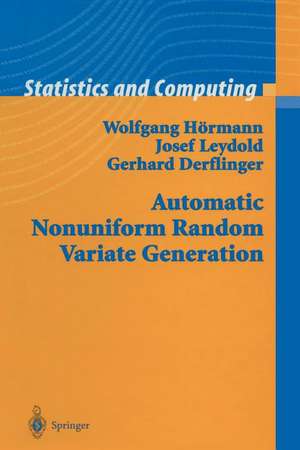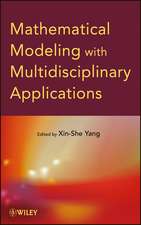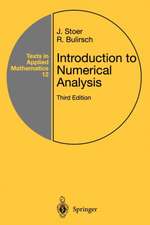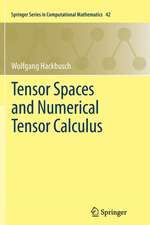Automatic Nonuniform Random Variate Generation: Statistics and Computing
Autor Wolfgang Hörmann, Josef Leydold, Gerhard Derflingeren Limba Engleză Paperback – 10 oct 2011
| Toate formatele și edițiile | Preț | Express |
|---|---|---|
| Paperback (1) | 646.94 lei 6-8 săpt. | |
| Springer Berlin, Heidelberg – 10 oct 2011 | 646.94 lei 6-8 săpt. | |
| Hardback (1) | 654.62 lei 6-8 săpt. | |
| Springer Berlin, Heidelberg – 23 oct 2003 | 654.62 lei 6-8 săpt. |
Din seria Statistics and Computing
-
 Preț: 228.21 lei
Preț: 228.21 lei -
 Preț: 438.82 lei
Preț: 438.82 lei -
 Preț: 386.81 lei
Preț: 386.81 lei - 20%
 Preț: 753.97 lei
Preț: 753.97 lei - 20%
 Preț: 1059.77 lei
Preț: 1059.77 lei -
 Preț: 426.72 lei
Preț: 426.72 lei - 20%
 Preț: 474.37 lei
Preț: 474.37 lei - 18%
 Preț: 1387.07 lei
Preț: 1387.07 lei -
 Preț: 433.53 lei
Preț: 433.53 lei -
 Preț: 208.58 lei
Preț: 208.58 lei - 20%
 Preț: 1454.73 lei
Preț: 1454.73 lei -
 Preț: 377.18 lei
Preț: 377.18 lei - 23%
 Preț: 652.30 lei
Preț: 652.30 lei - 20%
 Preț: 1174.26 lei
Preț: 1174.26 lei - 20%
 Preț: 505.19 lei
Preț: 505.19 lei - 18%
 Preț: 959.32 lei
Preț: 959.32 lei - 15%
 Preț: 643.48 lei
Preț: 643.48 lei -
 Preț: 392.75 lei
Preț: 392.75 lei - 15%
 Preț: 640.06 lei
Preț: 640.06 lei -
 Preț: 404.29 lei
Preț: 404.29 lei - 15%
 Preț: 710.42 lei
Preț: 710.42 lei - 15%
 Preț: 695.85 lei
Preț: 695.85 lei - 20%
 Preț: 1276.86 lei
Preț: 1276.86 lei - 18%
 Preț: 1003.38 lei
Preț: 1003.38 lei - 15%
 Preț: 703.85 lei
Preț: 703.85 lei -
 Preț: 384.70 lei
Preț: 384.70 lei - 15%
 Preț: 606.17 lei
Preț: 606.17 lei - 15%
 Preț: 589.02 lei
Preț: 589.02 lei - 18%
 Preț: 1117.99 lei
Preț: 1117.99 lei -
 Preț: 503.52 lei
Preț: 503.52 lei - 18%
 Preț: 735.38 lei
Preț: 735.38 lei - 15%
 Preț: 693.90 lei
Preț: 693.90 lei
Preț: 646.94 lei
Preț vechi: 761.10 lei
-15% Nou
Puncte Express: 970
Preț estimativ în valută:
123.79€ • 129.25$ • 102.45£
123.79€ • 129.25$ • 102.45£
Carte tipărită la comandă
Livrare economică 05-19 aprilie
Preluare comenzi: 021 569.72.76
Specificații
ISBN-13: 9783642073724
ISBN-10: 3642073727
Pagini: 452
Ilustrații: X, 441 p. 89 illus.
Dimensiuni: 155 x 235 x 24 mm
Greutate: 0.6 kg
Ediția:Softcover reprint of the original 1st ed. 2004
Editura: Springer Berlin, Heidelberg
Colecția Springer
Seria Statistics and Computing
Locul publicării:Berlin, Heidelberg, Germany
ISBN-10: 3642073727
Pagini: 452
Ilustrații: X, 441 p. 89 illus.
Dimensiuni: 155 x 235 x 24 mm
Greutate: 0.6 kg
Ediția:Softcover reprint of the original 1st ed. 2004
Editura: Springer Berlin, Heidelberg
Colecția Springer
Seria Statistics and Computing
Locul publicării:Berlin, Heidelberg, Germany
Public țintă
ResearchCuprins
1 Introduction.- 2 General Principles in Random Variate Generation.- 3 General Principles for Discrete Distributions.- 4 Transformed Density Rejection (TDR).- 5 Strip Methods.- 6 Methods Based on General Inequalities.- 7 Numerical Inversion.- 8 Comparison and General Considerations.- 9 Distributions Where the Density Is Not Known Explicitly.- 10 Discrete Distributions.- 11 Multivariate Distributions.- 12 Combination of Generation and Modeling.- 13 Time Series (Authors Michael Hauser and Wolfgang Hörmann).- 14 Markov Chain Monte Carlo Methods.- 15 Some Simulation Examples.- List of Algorithms.- References.- Author index.- Selected Notation.- Subject Index and Glossary.
Recenzii
From the reviews:
"The book discusses random variate generation generally, with some emphasis on methods that use the concavity properties of transformations of a density to design rejection algorithms. … Overall, this is a good book that accurately reflects the current state of the art in designing generation algorithms, including many contributions from the authors." (Michael J. Evans, Mathematical Reviews, 2006 b)
"The main topic of the book are universal generators, i.e. the generators usable for a broad class of distributions … . It benefits from the long term research of the authors. All known important methods for the construction of universal nonuniform generators are presented together with the algorithms of corresponding generators. … The book can serve as a monograph and as a textbook. The book is a good choice for everybody interested in nonuniform random number generators." (Jaroslav Král’, Zentralblatt MATH, Vol. 1038 (13), 2004)
"Many statistical methods make use of simulation. … What if we want to simulate from a t-distribution with parameter 2.3? What if the distribution is specified by means of its hazard function? This fascinating book is the place to look for answers to questions such as these. … where the book is particularly interesting is when it presents a variety of ‘automatic methods’. … This book is essential reading for users of simulation and is destined to become a classical reference for the area." (B.J.T. Morgan, Short Book Reviews, Vol. 24 (3), 2004)
"This important book deals with the algorithmic development of the generation of random variables for discrete and continuous ‘large distribution’ families. … The authors introduce a library of algorithms that can generate random variates from a multitude of distributions. These universal generators are termed UNU.RAN and are available from the authors’ Web site. … The mathematics that are introduced are usedintelligently, adding value to the practical edge. The coverage of the literature is comprehensive:-the-best that I have met." (Mohamed Afzal Norat, Journal of the Royal Statistical Society, Vol. 168 (1), 2005)
"This book … has its focus on an area which is usually not covered extensively, namely the search for automatic generators. … The book is also remarkable in that it is both a joy to read for a mathematician and a helpful guidance and reference for practical algorithms. … the text is a comprehensive and well-structured overview over the main ideas and relevant algorithms emanating from them … . It is a welcome and valuable enrichment of the literature about random variate generation … ." (Jakob Creutzig, Metrika, Vol. 64, 2006)
"This book describes approaches to simulating variates from discrete and continuous distributions … . The authors target a mixed audience of computer scientists and statisticians. … Each chapter concludes with an ample number of exercises, and comprehensive references for further study are provided. In summary, I have found this to be a useful reference, and would recommend it to any statistician who regularly engages in (or advises on) simulation studies." (Paul D. Baxter, Journal of Applied Statistics, Vol. 33 (8), 2006)
"Automatic Nonuniform Random Variate Generation is primarily a research monograph unifying the authors’ work in algorithms and software to sample from a large family of distributions … . The writing is very clear … and worked examples, often with graphical illustration, facilitate understanding. … I highly recommend this book and the accompanying webpages to graduate students and other researchers from many disciplines (e.g., statistics, computer science, physics, engineering) who need to simulate random variates from non-standard but low-dimensional densities as a part of their research." (Mary Kathryn Cowles, Journal of the American Statistical Association, Vol. 102(479), 2007)
"The book discusses random variate generation generally, with some emphasis on methods that use the concavity properties of transformations of a density to design rejection algorithms. … Overall, this is a good book that accurately reflects the current state of the art in designing generation algorithms, including many contributions from the authors." (Michael J. Evans, Mathematical Reviews, 2006 b)
"The main topic of the book are universal generators, i.e. the generators usable for a broad class of distributions … . It benefits from the long term research of the authors. All known important methods for the construction of universal nonuniform generators are presented together with the algorithms of corresponding generators. … The book can serve as a monograph and as a textbook. The book is a good choice for everybody interested in nonuniform random number generators." (Jaroslav Král’, Zentralblatt MATH, Vol. 1038 (13), 2004)
"Many statistical methods make use of simulation. … What if we want to simulate from a t-distribution with parameter 2.3? What if the distribution is specified by means of its hazard function? This fascinating book is the place to look for answers to questions such as these. … where the book is particularly interesting is when it presents a variety of ‘automatic methods’. … This book is essential reading for users of simulation and is destined to become a classical reference for the area." (B.J.T. Morgan, Short Book Reviews, Vol. 24 (3), 2004)
"This important book deals with the algorithmic development of the generation of random variables for discrete and continuous ‘large distribution’ families. … The authors introduce a library of algorithms that can generate random variates from a multitude of distributions. These universal generators are termed UNU.RAN and are available from the authors’ Web site. … The mathematics that are introduced are usedintelligently, adding value to the practical edge. The coverage of the literature is comprehensive:-the-best that I have met." (Mohamed Afzal Norat, Journal of the Royal Statistical Society, Vol. 168 (1), 2005)
"This book … has its focus on an area which is usually not covered extensively, namely the search for automatic generators. … The book is also remarkable in that it is both a joy to read for a mathematician and a helpful guidance and reference for practical algorithms. … the text is a comprehensive and well-structured overview over the main ideas and relevant algorithms emanating from them … . It is a welcome and valuable enrichment of the literature about random variate generation … ." (Jakob Creutzig, Metrika, Vol. 64, 2006)
"This book describes approaches to simulating variates from discrete and continuous distributions … . The authors target a mixed audience of computer scientists and statisticians. … Each chapter concludes with an ample number of exercises, and comprehensive references for further study are provided. In summary, I have found this to be a useful reference, and would recommend it to any statistician who regularly engages in (or advises on) simulation studies." (Paul D. Baxter, Journal of Applied Statistics, Vol. 33 (8), 2006)
"Automatic Nonuniform Random Variate Generation is primarily a research monograph unifying the authors’ work in algorithms and software to sample from a large family of distributions … . The writing is very clear … and worked examples, often with graphical illustration, facilitate understanding. … I highly recommend this book and the accompanying webpages to graduate students and other researchers from many disciplines (e.g., statistics, computer science, physics, engineering) who need to simulate random variates from non-standard but low-dimensional densities as a part of their research." (Mary Kathryn Cowles, Journal of the American Statistical Association, Vol. 102(479), 2007)
Caracteristici
Includes supplementary material: sn.pub/extras














